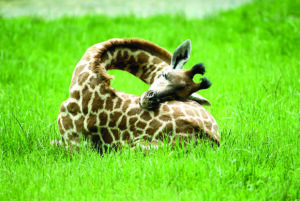By Dr. Beth Leermakers
My dogs sleep a lot. As someone who rarely gets the recommended seven hours of sleep, I envy my snoozing companions. I used to feel guilty leaving my dogs home alone — until I started working from home and discovered that they sleep most of the day (in another room).
How do the sleep habits of dogs compare to other animals? Let’s take a look.

Photo courtesy of Bored Panda
Monophasic vs. Polyphasic sleep patterns. Polyphasic sleep — sleeping in multiple short periods throughout a 24-hour cycle — is more common, especially for animals that need to watch for predators.
Dogs take multiple naps throughout the day. Rodents sleep during both light and dark periods of a 24-hour cycle, with multiple short sleep episodes throughout the day and night. Birds and many land and marine mammals are also polyphasic sleepers.
Monophasic sleep refers to getting sleep in one concentrated time period, like people do. We sleep for extended periods at night, remaining alert and active (ish) during the day.
Other primates, including marmosets and rhesus monkeys, also have monophasic sleep patterns. Marmosets sleep in trees surrounded by their family, helping them feel safe.
Some animals experience unihemispheric sleep, where one side of the brain sleeps while the other side stays awake. This allows the animals to gain the restorative benefits of sleep while still watching out for potential threats. Dolphins, eared seals, manatees and birds sleep unihemispherically.
Mammals sleep to save and restore their mental and physical energy. Sleep needs and habits depend on several factors, including age, body size, environment, diet and safety of the animal’s sleep site.
All mammals studied thus far exhibit signs of REM sleep, suggesting that mammals dream. The amount of time spent in REM and non-REM sleep varies by animal.
Giraffes have adapted to survive on very little sleep. They may only sleep 30 minutes to two hours per day in the wild, in short bouts of 5-10 minutes. They may sleep up to 4 1/2 hours per day in captivity. In the wild, where they must be ready to flee from predators, giraffes usually sleep standing up, sometimes leaning against a tree. In captivity, where they feel safe, they may lie down to sleep.
At the other extreme, brown bats sleep about 20 hours per day, with some of that time spent in a state of torpor, or hibernation. During torpor, animals have a lower metabolism, heart rate, respiration rate and body temperature, conserving energy. During colder months when insects (their food source) are scarce, bats can conserve their energy by entering torpor for a few hours on a cold day or hibernating for a few months until insects return in the spring.
Bats hang upside down to sleep, allowing them to conserve energy and escape quickly if threatened. Specially adapted feet lock onto surfaces without requiring muscle effort, letting them hang securely while they rest.
Dogs are polyphasic sleepers, but they tend to have longer sleep periods at night, with short naps during the day. Their sleep needs vary according to age. Research suggests that puppies sleep at least 11 hours a day, while adult dogs need about 8-13 1/2 hours per day. Senior dogs nap more frequently during the day.
More than half of cats sleep 12-18 hours per day, and almost 40 percent sleep more than 18 hours. Cats are polyphasic sleepers, sleeping multiple times each day (for an average of 78 minutes per cat nap).
Cats are crepuscular, meaning they are most active during twilight periods, specifically during dawn and dusk. This allows cats to hunt diurnal birds and nocturnal rodents that are active during twilight hours.
Walruses sleep between 19 and 21 hours a day, both on land and in the water, though they rest for longer periods on land. In the water, they may lie at the bottom, float on the surface, or lean against an object while standing upright. They’re even known to hook their tusks onto an ice floe to sleep. Walruses can go without sleep for several days, swimming for up to 3.5 days before needing rest.
Dolphins typically sleep for about eight hours per day. Unihemispheric sleep allows dolphins to maintain some level of awareness of their surroundings and control their swimming to surface for air.
When dolphins sleep, they often float near the surface of the water (on their sides or upright), letting them breathe easily while resting. They may also swim slowly in a circular pattern or stay close to other dolphins for safety.
As diverse as the animal kingdom’s sleep patterns are, they serve a common purpose: to recharge and restore the body, even while staying alert to potential threats. My dogs are lucky that their biggest threat is that someone will steal their favorite chew toy.
